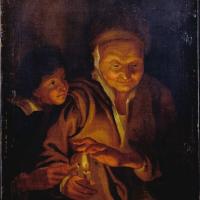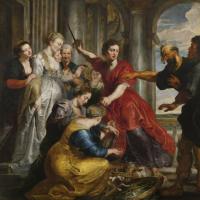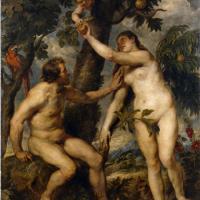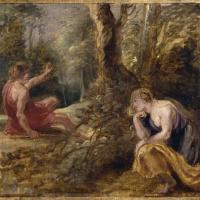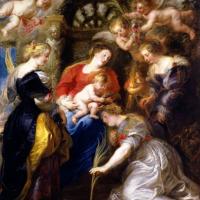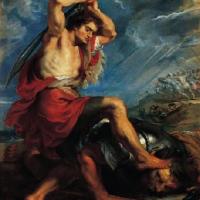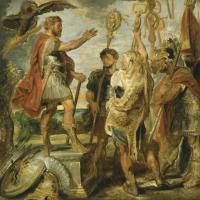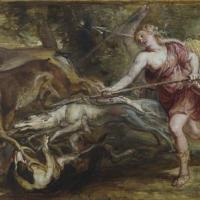Peter Paul Rubens
Adam And Eva
$480.00
Apollo And The Python
$480.00
Aurora Abducting Cephalus
$480.00
Cephalus And Procris
$540.00
Ceres And Pan
$540.00
Cimon En Pero
$540.00
Crowning Of Saint Catherine
$540.00
Cupids Harvesting
$480.00
David Slaying Goliath
$480.00
Deucalion And Pyrrha
$480.00
Diana And Her Nymphs Hunting
$480.00
Peter Paul Rubens
Peter Paul Rubens (1577-1640)
Peter Paul Rubens ( Petrus Paulus Rubens , or Peter Paul Rubens in Dutch , and Pietro Paolo Rubens from 1608, born on June 28, 1577 in Siegen ( Nassau-Siegen ) and died on May 30, 1640 in Antwerp , is a Flemish Baroque painter .
Assisted by an important workshop, Rubens produces a considerable work in various genres. He agrees to paint a large number of portraits but, "instinctively more interested in great works than in small curiosities" as he wrote himself, he pays little attention to details, which he does not paint. in depth and draws a few lines. Indeed, he will work at an extremely productive pace, producing 1403 paintings according to Michel Jaffé's catalog. He produces mainly religious projects, mythological paintings, and important series of historical paintings. Prized by the great for the erudition and the charm of his conversation, he also plays an important diplomatic role in his time and enjoys an unparalleled social position among the artists of his time.
Peter Paul Rubens was born in Siegen in Westphalia , in the Holy Roman Empire 300 km from Antwerp . Rubens spent his first ten years in Siegen. Having abjured Protestantism for Catholicism. Many of his paintings depict religious subjects and Rubens is also later became a leading voice of the pictorial style of the Catholic Counter-Reformation. At the age of 14, he was apprenticed from 1589 to 1598 , first with the painter Tobias Verhaecht , then with some eminent painters of his time, including Adam van Noort and Otto van Veen . Much of his initial training is devoted to copying the works of ancient artists, such as xylographies of Holbein the Younger and engravings by Marcantonio Raimondi after Raphael . When he had completed his training, he entered the guild of St. Luke in 1598 as an independent master.
Rubens spent the last ten years of his life in Antwerp. On an artistic level, he received new orders of Habsburg and he continued to work for foreign clients, for example by making the ceiling paintings in the Banqueting House of Whitehall Palace , but he also explored other artistic paths more personal, composing landscapes, such as the Rainbow Landscape (1635, Louvre Museum, Paris) and more intimate works as well as portraits of his wife, his children and the Moretus family -Plantin ( Plantin-Moretus Museum ).
IRubens spent the last ten years of his life in Antwerp. On an artistic level, he received new orders of Habsburg and he continued to work for foreign clients, for example by making the ceiling paintings in the Banqueting House of Whitehall Palace , but he also explored other artistic paths more personal, composing landscapes, such as the Rainbow Landscape (1635, Louvre Museum, Paris) and more intimate works as well as portraits of his wife, his children and the Moretus family -Plantin ( Plantin-Moretus Museum ).
A year before, Charles I st of England had given him the realization of the painted ceiling of the Banqueting House at Whitehall Palace designed by architect Inigo Jones . But his most important command was that of sixty canvases for the decoration of the hunting lodge of Philip IV of Spain , the Tower of Parada , for which he was inspired by the work of Ovid , the Metamorphoses .
Moreover, when Mary of Medici experienced her ultimate exile , it is Rubens who collected it and who protected it until his death. She also ends her life, two years after the death of the painter, in the house of this one.
For his part, Rubens falls ill because of his chronic gout , his condition worsens and he eventually died on May 30, 1640, leaving behind eight children, three with Isabella and five with Helen, her youngest child being born three months before his death. He is buried at St. Jacob's Church (Sint-Jacobskerk) (nl) of Antwerp.
Rubens is not only a renowned artist but also a diplomat and a skilled trader, making him a character then known throughout Europe. His workshop in Antwerp mobilizes very diverse talents, such as Frans Snyders for animal painting; his most important collaborators are Jacob Jordaens and Antoine van Dyck . His artistic fortune is immense, through a body of paintings and drawings: one of the painters who admired him the most, Delacroix called him the "Homer of painting", and Rubens embodies the primacy of color in the world. history of European art from the xvii th century, continuing in this the lesson of the great Venetians and still one of the most important painters of Western art. The art historian Chennevières also creates the terms of chickens and rubenists to evoke the quarrel between rubenists (the colorists who favor the force of sensation) and chickens (the designers who favor the form) which is part of the quarrel of the Ancients and the Moderns.
During the auction of July 10 , 2002 at Sotheby's , Rubens' painting The Massacre of the Innocents was sold for a price of 60.98 million euros (£ 400 million, £ 49.5 million, $ 76.2 million) to Lord Thomson.


